Sightseeing Down & Dirty List - Just the Basics
Alcatraz Island
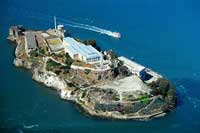
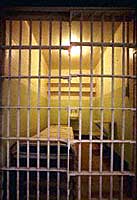 Dubbed "The Rock" by inmates, this maximum security prison housed an average of 264 of the country's most dangerous criminals making their way to Alcatraz through disobedience at other prisons in the US.
Dubbed "The Rock" by inmates, this maximum security prison housed an average of 264 of the country's most dangerous criminals making their way to Alcatraz through disobedience at other prisons in the US.
Prisoners spent between 16 and 23 hours every day alone in stark cells equipped with only a toilet and bunk. Many cells measured only 5 feet by 9 feet.Famous inmates include: Al Capone, Robert Stroud, the Anglin Brothers, George Kelly and Carnes, Thompson and Shockley.
Alcatraz was turned into a civilian prison in 1934 by the Federal Bureau of Prisons and then closed in 1963. The island was occupied by American Indians from 1969 to 1971.
Take a Tour of Alcatraz
Enjoy a full tour of Acatraz Island with a Cell Block Audio Tour as well as 3 days of Open-Top Hop-On Hop Off Sight Seeing Tour including the Official City Tour, Park & Zoo Tour & the Sausalito Tour.
Take the Alcatraz TourEscape from the Rock Cruise
Tour Alcatraz from a Bay Cruise - Sail out and under the Golden Gate Bridge, circle around Alcatraz Island while listening to chilling stories of Alcatraz famous escapes. You will be taken back in time to when this prison was the most feared penal institution in America.
Take the Alcatraz CruiseCable Cars
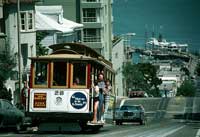
In 1873, Andrew Hallidie, inventor of the Cable Car, was on board for the launch of the cable car system.
Before the 1906 earthquake, more than 600 cars were in use. Hallidie was inspired to build the cable car system due to witnessing an awful accident. A horse drawn tram slipped down a hill, dragging the horses with it.
Cable Car Barn
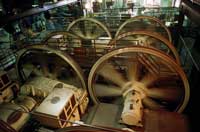
Both a museum and the power behind the cable car system, the Cable Car Barn is located at 1201 Mason Street and is open 10am to 5pm daily. The engines and wheels that wind the cables through the system of channels and pulleys beneath the city streets are anchored to the ground floor.
Chinatown
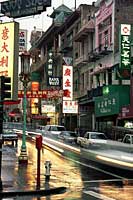
Second only in size to New York City's 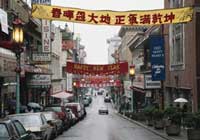 Chinatown, it is the largest Chinese community on the West Coast. Initially only a small community at Portsmouth Square, once the gold strike began, the Cantonese came by the boatload, fleeing famine and the Opium Wars. By 1850 there were more than 4,000 Chinese men (and only 7 Chinese women) in the area. Chinese "coolies" (from the word kuli meaning bitter toil in Chinese) were tolerated only if they performed work scorned by others.
Chinatown, it is the largest Chinese community on the West Coast. Initially only a small community at Portsmouth Square, once the gold strike began, the Cantonese came by the boatload, fleeing famine and the Opium Wars. By 1850 there were more than 4,000 Chinese men (and only 7 Chinese women) in the area. Chinese "coolies" (from the word kuli meaning bitter toil in Chinese) were tolerated only if they performed work scorned by others.
When the area was totally destroyed by the 1906 earthquake and fire, city politicians planned to relocate the Chinese to less valuable property. The industrious Chinese rebuilt with such speed that they reclaimed their district before City Hall could act.
Rather than on the more highly tourist populated Grant Avenue, locals shop on Stockton where the freshest vegetables, produce and fish spill over in boxes onto the crowded streets.
Coit Tower
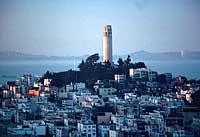
Lillie Hitchcock Coit, a very colorful character who as a girl was the mascot of the famed Knickerbocker No. 5 firefighting team, left funds to beautify the City in 1929. From these funds Coit Tower was built in 1933. In 1934 murals that were sponsored by a government-funded program for artists during the Great Depression were unveiled and caused quite a stir with their political content. Scenes range from a robbery on the streets of the financial district to dockyards, factories and wheat fields. There are many fascinating details in these murals with much social commentary depicting labor problems and social injustice.
Ghiradelli Square
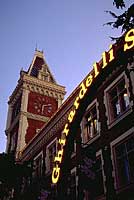
A beautiful refurbished red brick building, once a chocolate factory and woolen mill now houses many elegant shops and restaurants. Retaining the famous trademark clock tower and the original bright electric sign at the top, beneath the tower Ghiradelli Chocolate Manufacturing still houses the vintage chocolate making machinery. You can also purchase the famous chocolate bars although they are now made in San Leandro.
Cliff House
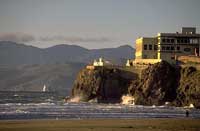
Today the fifth rendition of the Cliff House is left standing. Originally built in 1863, when the schooner Parallel, loaded to the hilt with dynamite crashed on the rocks below, a whole wing of the building was lost. The Cliff House over time became associated with local powerbrokers, crime bosses and their molls.
Seven years later, on Christmas Day, the entire building burned to the ground. Adolph Sutro rebuilt it in 1895, but once again that year it burned. Little remains of the last building on he site which opened in 1909 as remodeling and repair work have obliterated the building's original character. Currently there are restaurants on the upper level and a visitor's center and two attractions, the Camera ""Obscura and the Musee Mecanique on the lower.
Japanese Tea Gardens
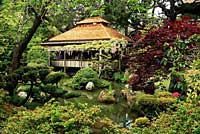
Golden Gate Park
Built for the California Midwinter International Exposition of 1894 by the art dealer George Turner Marsh. In 1895 the tea garden was contracted over to Makota Hagiwara and his family who tended it with loving devotion. The Hagiwaras maintained the garden until World War II, when they, along with 110,000 other Japanese-Americans, were interned during World War II.
The architecture and landscape of this garden blend subtly and with great beauty in a harmonious pattern of bridges, footpaths, pools, flowers, trees, statuary, shrines and gates. It is especially breathtaking in April when the cherry trees are in bloom.
The Bronze Buddha, donated by the Gump brothers in 1949, is the largest bronze Buddha outside Asia, cast in Japan in 1790. The Bronze Buddha is seated at the top of the garden stairs.
Golden Gate Bridge
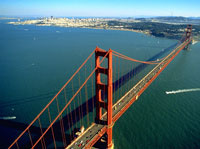
Named after that part of San Francisco Bay called "Golden Gate" by John Fremont in 1844, the bridge opened in 1937, connecting the city with Marin County. Breathtaking views are offered from this spectacular, world-famous landmark, which has six lanes for vehicles plus a free pedestrian walkway. It is the world's third-largest single-span bridge and, when it was built, was the longest and tallest suspension structure.
Japan Center
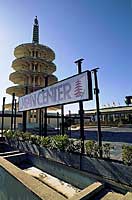
Built in the 1960's in with the ambitious intentions to revitalize the Fillmore District. The Geary Expressway and the Japan Center's large shopping area replaced many blocks of aging Victorian houses which were demolished for this implementation. Marking the heart of the complex and centered upon a five tiered 75-ft concrete pagoda, is the Peace plaza. Taiko drummers and others perform here at the annual Cherry Blossom Festival each April. On either side of the pagoda are malls lined with Japanese shops and restaurants.
Castro Street
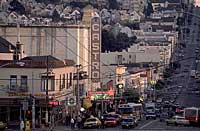
The hilly neighborhood around Castro Street between Twin Peaks and the Mission District is the heart of San Francisco's high-profile gay and lesbian community. Focused on the intersection of Castro Street and 18th Street, the self-proclaimed "Gayest Four Corners of the World" emerged as a homosexual nexus during the 1970's. Gays of the Flower Power generation moved into this predominantly working-class district and began restoring Victorian houses setting up such businesses as the bookstore, A Different Light, at 489 Castro Street. Though the many shops and restaurants attract all kinds of people, the Castro's openly homosexual identity has made it a place of pilgrimage for gays and lesbians. It symbolizes for this minority group a freedom not generally found in cities elsewhere.
The city's first prominent and openly gay politician, Harvey Milk, was known as the Mayor of Castro Street before he was assassinated on November 28, 1978. He and Mayor George Moscone were killed by an ex-policeman, whose lenient sentence caused outrage.
Museum of Modern Art
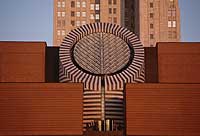
This dramatic museum forms the nucleus of San Francisco's reputation as a leading center of modern art. Created in 1935 with the aim of displaying works from 20th-century artists, it moved into its new quarters in 1995. The focus of Swiss architect Mario Botta's modernist building is the 125-ft cylindrical skylight which channels light down to the first -floor atrium court.
More than 17,000 works of art are housed in its 50,000 square feet of gallery space on four floors. The museum offers a dynamic schedule of changing exhibits from around the world.
Union Square
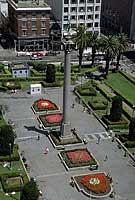
Union Square, the park for which the area is named, is filled with chess players, trysting lovers, panhandlers, soapbox orators of every political and religious persuasion and many pigeons. Many of San Francisco's largest department stores can be found here, including Macy's, Neiman Marcus, Nordstrom's, Gumps, Saks Fifth Avenue, Tiffany's, and Cartier as well as grand hotels, antiquarian bookshops and boutiques.
Maiden Lane is an elegant, tree-lined alley that extends two blocks east of Union Square from Stockton to Kearny Streets. Once known as Morton Street and considered disreputable, it now features exclusive shops and sidewalk bistros.
The Painted Ladies
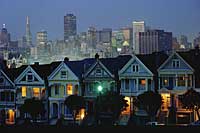
San Francisco's Victorian Architecture
Despite earthquakes, fires and the inroads of modern life, thousands of ornate, late 19th-century houses still line the streets of San Francisco. In fact, in many neighborhoods they are by far the most common type of housing. Victorian houses are broadly similar, in that they all have wooden frames, elaborately decorated with mass produced ornament. Most were constructed on narrow plots to a similar floor plan, but they differ in the features of the facade. Four main styles prevail in the city, although in practice many houses, especially those built in the 1880s and 1890s, combine aspects of two or more styles. The styles are Gothic Revival (1850-80), Italianate (1850-85), Stick (1860-90) and Queen Anne (1875-1905). Details and examples are available in San Francisco & Northern California Eyewitness Travel Guide.
Pier 39
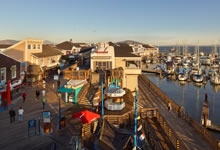
PIER 39 is a 45-acre waterfront complex that is a gathering place for millions of San Francisco locals and visitors. In addition to its 14 full-service restaurants, 90+ shops and popular attractions, PIER 39 is home to a 5-acre waterfront park and a 300-berth marina. PIER 39 is known for its spectacular views of San Francisco Bay including the Golden Gate Bridge, Bay Bridge and Alcatraz, as well as the world famous California sea lions hauled out on K-Dock.